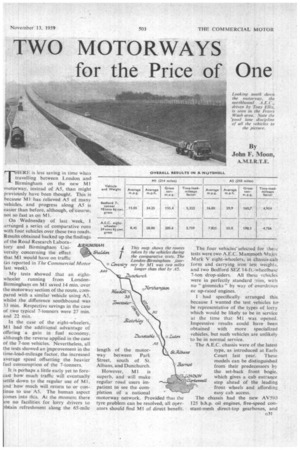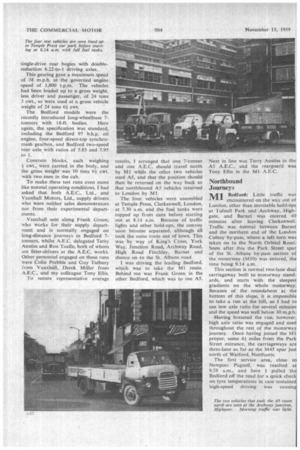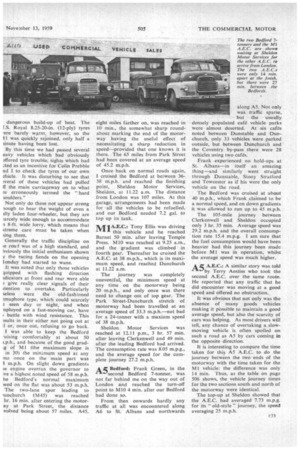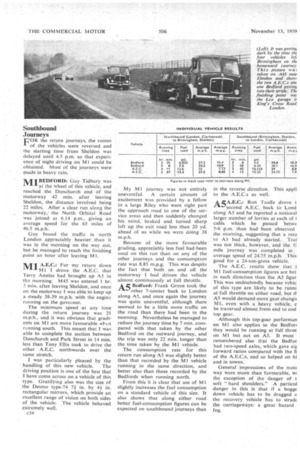TWO MOTORWAYS for the Price of One
Page 153

Page 154

Page 175

Page 176

If you've noticed an error in this article please click here to report it so we can fix it.
THERE is less saving in time when travelling between London and Birmingham on the new MI motorway, instead of A5, than might previously have been thought. This is because MI has relieved A5 of many vehicles, and progress along A5 is easier than before, although, of course, not so fast as on Ml.
On Wednesday of last week, I arranged a series of comparative runs with four.vehicles over these two roads. Results obtained backed up the findings of the Road Research Laboratory and Birmingham Uni versity concerning the effect that MI would have on traffic
(as reported in The Commercial Motor last week).
My tests showed that an eightwheeler running from LondonBirmingham on M1 saved 14 min. over the motorway section of the route, C3111pared with a similar vehicle using A5, whilst the difference southbound was 33 min. Respective savings in the case of two typical 7-tonners were 27 min. and 22 min.
En the case of the eight-wheelers, Ml had the additional advantage of offering a gain in fuel economy, although the reverse applied in the case of the 7-ton vehicles. Nevertheless, all the tests showed an improvement in the time-load-mileage factor, the increased average speed offsetting the heavier fuel consumption of the 7-tonners.
It is perhaps a little early yet to forecast how much traffic will eventually ettle down to the regular use of Ml, nd how much will return to or coninue to use A5. The human aspect omes into this. At the moment there re no facilities for lorry drivers to btain refreshment along the 65-mile length of the motorway between Park Street, south of St. Albans, and Dunchurch.
However, M1 is superb, and will make regular road users impatient to see the completion of a national motorway network. Provided that the tyre problem can be resolved, all operators should find M1 of direct benefit. The four vehicles' selected for these tests were two A.E.C. Mammoth Majoi Mark V eight-wheelers,in 'chassis-cab form and carrying iron test weights, and two Bedford SEZ 14-ft.-wheelbase7-ton drop-siders. All these vehicleS were in perfectly standard trim, with no " gimmicks " by way of overdrives or up-rated engines.
I had specifically, arranged this because I wanted the test vehicles to be representative of the types of lorry which would be likely to be in service at the time that Ml was opened. Impressive results could have been obtained with more specialized vehicles, but such vehicles are unlikely to be in normal service.
• The A.E.C. chassis were of the latest type, as introduced at Earls Court last year. These models can be distinguished from their predecessors by the set-back front bogie.
NDRAr which gives a cab entrance CZarionvill step ahead of the leading
A. front wheels and affording easy cab access.
The chassis had the new AV590 125 b.h.p. oil engines, five-speed constant-mesh direct-top gearboxes, and o31 net single-drive rear bogies with doublereduction 6.22-to-I driving axles.
This gearing gave a maximum speed of .38 m.p.h. at the governed engine speed of 1,800 r.p.m. The vehicles had been loaded up to a gross weight, less driver and passenger, of 24 tons 3 cwt., so were used at a gross vehicle weight of 24 tons 6+ cwt.
The Bedford models were the recently introduced long-wheelbase 7 tonners with 18-ft. bodies. Here again, the specification was standard, including the Bedford 97 b.h.p. oil engine, four-speed direct-top synchromesh gearbox, and Bedford two-speed rear axle with ratios of 5.83 and 7.95 to 1.
Concrete blocks, each weighing cwt., were carried in the body, and the gross weight was 10 tons 64 cwt. with two men in the cab.
• To make these test runs even more like normal operating conditions, I had asked that both A.E.C., Ltd., and Vauxhall Motors, Ltd., supply drivers who were neither sales demonstrators nor from their experimental depart ments. "
Vauxhall sent along Frank Green, who works for their supply department and is .normally engaged on long-distance journeys in Bedford 7tonners, whilst A.E.C. delegated Terry Anstiss and Ron Taaffe, both of whom are fitter-drivers at the A.E.C. works. Other personnel engaged on these runs were Colin Prebble and Guy Tidbury from Vauxhall, Derek Miller from A.E.C., and my colleague Tony Ellis, To secure representative average
results, 1 arranged that one 7-tonner and one A.E.C. should travel north by M1 while the other two vehicles used A.5, and that the position should then be reversed on the way back so that northbound A5 vehicles returned Co London by MI.
The four vehicles were assembled at Temple Press, Clerkenwell, London, at 7.30 a.m. and the fuel tanks were topped up from cans before starting out at 8.14 a.m. Because of traffic lights and other hold-ups, the convoy soon became separated, although all took the same route out of town. This was by way of King's Cross, York Way, Junction Road, Archway Road, High Road Finchley, Barnet and thence on to the St. Albans road.
I was driving the leading Bedford, which was to take the M1 route. Behind me was Frank Green in the other Bedford, which was to use A5. Next in line was Terry Anstiss in the A5 A.E.C., and the rearguard was Tony Ellis in the MI A.E.C.
Northbound Journeys •
mi Bedford: Little traffic was encountered on the way out of London, other than inevitable hold-tips at Tufnell Park and Archway, Highgate, and Barnet was entered 40 minutes after leaving Clerkenwell. Traffic was normal between Barnet and the northern end of -the London Colney by-pass, where a, left turn was taken on to the North Orbital Road. Soon after this the Park Street spur of the St. Albans by-pass section of the motorway (M10) was entered, the time being 9.14 a.m.
This section is normal two-lane dual carriageway built to motorway standards, and starts with the steepest gradients on the whole motorway. Because of the roundabout " at the bottom of this slope, it is impossible to take a run at the hill, so I had to use low axle ratio for several minutes and the speed was well below 30 m.p.h.
Having breasted the rise, however. high axle ratio was engaged and used throughout the rest, of the motorway journey. Once having joined the M1 proper, some 44miles from the Park Street entrance, the carriageways are three-lane as far as the M45 spur just north of Watford, Northants.
The first service area, close t Newport Pagnell, was reached at 9.58 a.m., and here J pulled
Bedford off the road for a quick check on tyre temperatures in case sustained high-speed driving was causing
dangerous build-up of heat. The J.S. Royal 8,25-20-in. (12-ply) tyres 'ere barely• warm-, however, so the 11 was quickly rejoined, only half a minute having been lost.
By this time we had passed several eavy vehicles which had obviously iffered tyre trouble, sights which had ted as an incentive for Colin Prebble rid I to check the tyres of our own ehicle. It was disturbing to see that :veral of these vehicles had pulled ff the main carriageway on to what re erroneously termed the "hard ioulders."
Not only do these not appear strong lough to bear the weight of even a illy laden four-wheeler, but they are :arcely wide enough to accommodate ri 8-ft, wide lorry, which means that ctreme care must be taken when sing them.
Generally the traffic discipline on re road was of a high standard, and bviously the initial enthusiasm shown y the racing fiends on the opening londay had started to wane.
It was noted that only those vehicles luipped with flashing direction idicators at front and rear were able m give really clear signals of their ttention to overtake. Particularly seless were the old-fashioned :maphore type, which could scarcely !, seen day or night, and when nployed on a fast-moving car, have battle with wind resistance. This :sults in their either not going out at or, once out, refusing to go back. I was able to keep the Bedford -uising comfortably at about 50 t.p.h., and because of the good gradLg of Ml (the maximum slope is in 30) the minimum speed at any me once on the main part was 3 m.p.h. On slight down gradients me engine overran the governor to [ye a highest noted speed of 58 m.p.h. he Bedford's normal maximum med on the flat was about 53 m.p.h. The two-lane spur leading to anichurch (M45) was reached hr. 16 min. after entering the motoray at Park Street, the distance volved being about 57 miles. A45,
eight miles farther on, was reached in 10 mm., the somewhat sharp roundabout marking the end of the motorway having the useful effect of necessitating a sharp reduction in speed—provided that one knows it is there. The 65 miles from Park Street had been covered at an average speed of 45.2 m.p.h.
Once back on normal roads again, I cruised the Bedford at between 3638 m.p.h. and reached the finishing point, Sheldon Motor Services, Sheldon, at 11.22 a.m. The distance from London was 107 miles. At this garage, arrangements had been made for all the vehicles to be refuelled, and our Bedford needed 7.2 gal. to top up its tank.
M1 A.E.C.: Tony Ellis• was driving
this vehicle and he reached Barnet 50 min. after leaving Temple Press. M10 was reached at 9.25 a.m., and the gradient was climbed in fourth gear. Thereafter he cruised the A.E.C. at 38 m.p.h., which is its maximum speed, and reached Dunchurch at 11.22 a.m.
The journey was completely uneventful, the minimum speed at any time on the motorway being 20 m.p.h., and only once was there need to change out of top gear. The Park Street-Dunchurch stretch of motorway had been travelled at an average speed of 33.3 m.p.h.—not bad for a 24-tonner with a maxium speed of 38 m.p.h.
Sheldon Motor Services was reached at 12.11 p.m., 3 hr. 57 min. after leaving Clerkenwell and 49 min. after the leading Bedford had arrived. The consumption rate was 8,05 m.p.g., and the average speed for the complete journey 27.2 m.p.h.
A4 Bedford: Frank Green, in the • -isecond Bedford 7-tonner, was not far behind me on the way out of London and reached the turn-off point to M10 4 min. after our Bedford had done so.
From then onwards hardly any traffic at all was encountered along A6 to St. Albans and northwards along A5. Not only was traffic sparse, • but the usually densely populated café vehicle parks were almost deserted. At six cafes noted between Dunstable and Dunchurch, only 33 vehicles were parked outside, but between Dunchurch and the Coventry by-pass there were 28 vehicles using two cafés.
Frank experienced no hold-ups at St. Albans—in itself an amazing thing—and similarly went straight through Dunstable, Stony Stratford and Towcester as if his were the only vehicle on the road.
The Bedford was cruised at about 40 m.p.h., which Frank claimed to be a normal speed, and on down gradients it was allowed to run up to 45 m.p.h.
The 105-mile journey between Clerk enwell and Sheldon occupied only 3 hr. 35 mm. Average speed was 29.2 m.p.h. and the overall consumption rate 15.4 m.p.g. I am sure that the fuel consumption would have been heavier had this journey been made before M1 was in operation, whilst the average speed was much higher.
Ac A.E.C.: A similar story was told •••)by Terry Anstiss who took the
second A.E.C. over the same route. He reported that any traffic that he did encounter was moving at a good speed and offered no obstruction.
It was obvious that not only was the absence of many goods vehicles making it possible to maintain a good average speed, but 'also the scarcity of cars was helping. As most drivers will tell, any chance of overtaking a.,slowmoving vehicle is often spoiled on such a road as A5 by cars coming in the opposite direction.
It is interesting to compare the time taken for this A5 A.E.C. to do the journey between the two ends of the motorway with the time taken for the M1 vehicle: the difference was only 14 min. Thus, as the table on page 506 shows, the vehicle journey times for the two sections south and north of the motorway were identical.
The top-up at Sheldon showed that the A.E.C. had averaged 7.73 m.p.g. for its " old-style " journey, the speed averaging 25 m.p.h.
Southbound Journeys
FOR the return journeys, the routes 1 of the vehicles were reversed and the starting time from Sheldon was delayed until 4.5 p.m. so that experience of night driving on MI could be obtained. Most of the journeys were made in heavy rain.
All BEDFORD: Guy Tidbury was 2at the wheel of this vehicle, and reached the Dunchurch end of the motorway 42 min. after leaving Sheldon, the distance involved being 22 miles. After a clear run along the motorway,• the North Orbital Road was joined at 6.14 p.m., giving an average speed for the 65 miles of 46.5 m.p.h.
Guy found the traffic in north London appreciably heavier than it was in the morning on the way out, but he managed to reach the finishing point an hour after leaving Ml,
mi A.E.C.: For my return down -1 M1 I drove the A.E.C. that Terry Anstiss had brought up AS in the. morning. M45 was entered 1 hr. 5 min. after leaving Sheldon, and once on the motorway I was able to keep up a steady 38-39 m.p.h. with the engine running on the governor.
The minimum speed at any time during the return journey was 21 m.p.h., and it was obvious that gradients on M1 are more favourable when running south. This meant that I was able to complete the section between Dunchurch and Park Street in 14 min. less than Tony Ellis took to drive the other A.E.C. northwards over the same stretch.
I was particularly pleased by the handling of this new vehicle. The driving position is one of the best that I have come across on a vehicle of this type. Gratifying also was the size of the Demo type-74 71 in. by 44 in. rectangular mirrors, which provide an excellent range of vision on both sides of the vehicle. The vehicle behaved extremely well.
c:34 My MI journey was not entirely uneventful. A certain amount of excitement was provided by a fellow in a large Riley who went right past the approach road to one of the service areas and then suddenly changed his mind, braked and turned sharp left up the exit road less than 20 yd. ahead of us while we were doing 38 m.p.h.
Because of the more favourable grading, appreciably less fuel had-been used on this run than on any of the other journeys and the consumption rate was 8.85 m.p.g. This was despite thc fact that both on. and off the motorway I had driven the vehicle almost continuously at full throttle.
A4 Bedford: Frank Green took the 'other 7-tonner back to London along A5, and once again the journey was quite uneventful, although there seemed to be a little more traffic on the road than there had been in the morning. Nevertheless he managed to reduce the journey time by 7 min. compared with that taken by the other Bedford on the outward journey, and the trip was only 22 min. longer than the time taken by the MI vehicle.
The consumption rate for this return run along AS was slightly better than that recorded by the M1 vehicle running in the same direction, and better also than those recorded by the Bedfords when running north.
From this it is clear that use of M1 slightly increases the fuel consumption on a standard vehicle of this size. It also shows that along either road better fuel-consumption figures can be expected on southbound journeys than
in the reverse direction. This appli to the A.E.C.s as well.
A4A.E.c.: Ron Taaffe drove t 'second A.E.C. back to Lond along A5 and he reported a noticeat larger number of lorries at each of t cafes which he passed betwc 5-6 p.m. than had been observed the morning, suggesting that a retu to A5 had already started. Trat was not thick, however, and the 1( mile journey was completed at average speed of 24.75 m.p.h. This good for a 24-ton-gross vehicle.
The A.E.C. results show that t MI fuel-consumption figures are bet in each direction than the A5 figur This was undoubtedly because vehic of this type are likely to be runni at full throttle on either road, but tl. A5 would demand more gear changh Ml, even with a heavy vehicle, c be traversed almost from end to end top gear.
Although this top-gear performan on M1 also applies to the Bedfor4 they would be running at full throt on Ml but not on A.5. It must remembered also that the Bedfor had two-speed axles, which gave eip forward ratios compared with the fi of the A.E.C.s, aud so helped on hi and in towns.
General impressions of the mot( way were more than favourable, wi the exception of the danger of t soft " hard shoulders." A partici]] danger in this is that if a bogge down vehicle has to be dragged c the recovery vehicle has to still& the carriageways: a great hazard fog.
































































































































































































































































